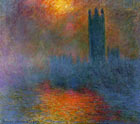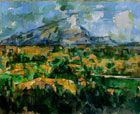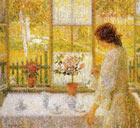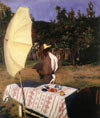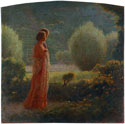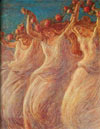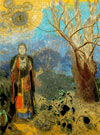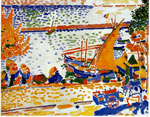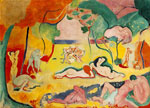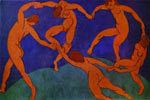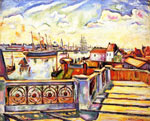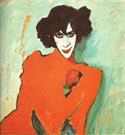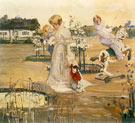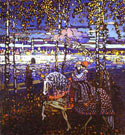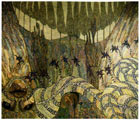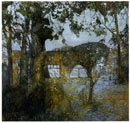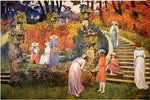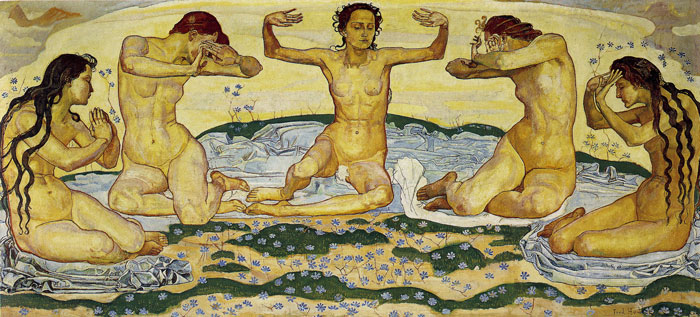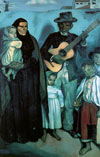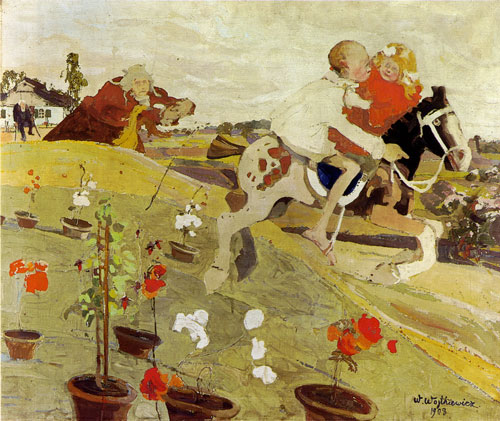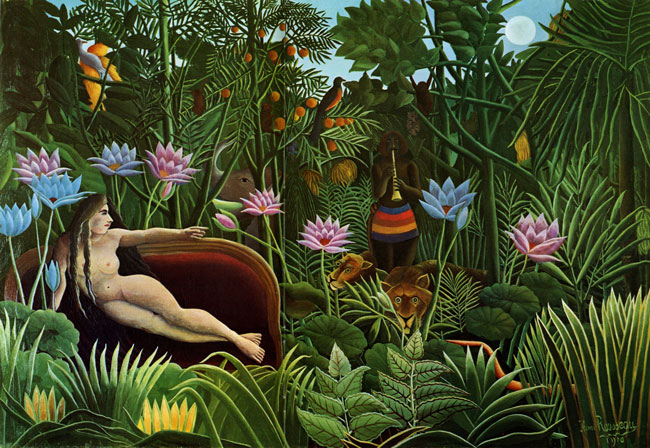
Moving Movements, History of Modern Painting, 1900 - 10
FIRST TEN YEARS OF PREVIOUS CENTURY: RISING OF FAUVISM, EXPRESSIONISM AND CUBISM,
BUT NOT THE END OF IMPRESSIONISM AND SYMBOLISM
In 1900 the telegraph connected the entire world. Only in the United States there were more then 1,4 million telephones, 8000 recorded automobiles and 24 million light bulbs. In 1900 Freud wrote his Traumdeutung and the First French woman got a function in court. Einstein's relativity theory dates from 1905 and in 1912 Bohr delivered the first illustrative model of an atom. In 1905 the first Russian revolution took place, with revolts and strikes. In 1908 Orville Wrights' first airplane flight took an hour.
click the thumbnails
Claude Monet
The parliament 1904
Paul Cézanne
Sainte-Victoire Mountain 1904-06
Paul Cézanne
The black Castle1906
Maximilien Luce
The Pile Drivers
Quai de la Seine at Billancourt 1902-1903
Leon de Smet
Woman at the Windows 1909
Károly Ferenczy
Octóber 1903
Pelliza da Volpedo
Quarto Estado
Pelliza da Volpedo
l'Amore nella Vita
Gaetano Previati
Dance of the Rose 1903
Leon Spilliaert
Night 1906
Odilon Redon
Bouddha 1905
Eugene Carriere
Woman with a Baby on her Lap
Frantisek Kupka
The voice of Silence1903
Frantisek Kupka
Babylon 1906
Mehoffer
Strange Garden 1903
André Derain
Port de Collioure,
le Chaval Blanc 1905
Henri Matisse
Happiness of Life 1906
Henri Matisse
The Dance 1910
Orthon Friesz
The harbour of Antwerp 1906
Orthon Friesz
La Ciotat 1907
Alexei von Jawlensky
Portrait of Alexander Sacharov 1909
Witold Wojtkiewicz
Rozstanie 1908
Wassily Kandinsky
Couple riding 1906
Gustav Klimt
The Kiss 1907-08
Vassili Ivanovitsj Denissov
The Sinn 1902
Boris Dmitrjevitsj Grigorjev
Stylised Landscape 1909
Tivadar Csontváry Kosztka
Roman Bridge at Mostar 1902
TivaTheo van Rysselberghe
The Garden of Felicien Rops 1910
Several styles were flourishing
When La libre Esthétique organised an exposition of impressionism in 1904, a lot of the first impressionists were already death: Pissarro, Manet, Sisley, Morisot,
Gauguin, Van Gogh, Seurat and Toulouse-Lautrec. Monet painted
his "Le parlement, ciel orageux" in 1901, almost abstract and resembling Turner. Cézanne worked colourful in spots, wet in wet, but also on dried ground, with sharp contours or shadow edges. Signac's strokes became bigger, vertical or horizontal on the canvas placed as bricks in a wall. Luce painted in a multicoloured pointillism: city views, but also social politics. Cross' pointillism catches the eye by light-darkness effects and special colours. New impressionists came, such as Leon De Smet in Belgium: with multicoloured, very light strokes his canvas radiates a unique atmosphere, with forms fading in vibrating light. In Hungary Ferenczy is the first really beautiful impressionist.
In France Vuillard painted fast, little contours, a lot of colours, squares, stripes and dots, all together. In the years '30 he will paint realistic again.
Also Loiseau is a very good painter, but also less quality art was coming up.
In Italy Balla, Boccioni and da Volpedo made a wonderful kind of pointillism, although the famous work "Quarto Estado" by de Volpedo was painted very realistic. The Spanish painters were not of the best, but an exception was Bastida.
The Art Nouveau was a style of "decadence": a mood of resignation and disillusion, without belief in a Supreme Being or progress in society. Painting was not aimed to serve mankind, but to personal reasons, as to cure, a kind of therapy. Some painters made good work in their "dark period", afterwards they degenerate. For example Spilliaert, who made wonderful work between 1900 and 1910, often in a mixed technique of ink, pastel, gouache and watercolour, with distinct contours, strong effects of light and darkness, in a hallucinating mood. Around 1913 his symbolism disappeared largely, to make place for a banal kind of impressionism.
Also Redon started to work more decorative, in bouquets, still lifes and portraits. But he also continued to make masterpieces: "Clouds of Flowers"
(1903) is a sailing boat aside and all what is left are the air and the sea, a crisscross of colours without form. "Buddha" (1903) before his tree, is surrounded by strange creatures. Redon's technique sometimes reminds Degas: several colour strokes mixed, as thin layers sliding over each other.
The Russian Vroebel, who was tortured by bursts of madness, made his seraphim with six wings in 1904, the hand with the lantern could have been painted by the much later Dubuffet!
Carrière made his mysterious scenes very veil and used only ochres, nevertheless always warm, never dull. Kupka worked in the greatest diversity: "Les joies" (1900) reminds Pissarro, "La Vague"
is sharp and wonderful, "Les baigneuses" (1906) looks impressionism,
"Le principe de la vie" (1900-1903) more surrealistic, such as his Sphinxes in: "La voie du silence". Mehoffer made
in 1903 his "Strange Garden": a sun-drenched flower garden with a giant dragonfly.
Munch was still working in his expressive Nabism with round forms. Gradually he renounced it and colour stripes came up. The following years he will bear more resemblance to German expressionism.
In Poland Stanislavski, Weiss and Slevinski painted wonderful in Art Nouveau.
Maurice De Vlaminck, Boujival, 1905 |
Fauvism In France some painters began to work more "wild" and were therefore called Fauvists. "Bougival" (1905) by De Vlaminck shows us fierce colours. Red and yellow are now more favourite then the blue and soft green of impressionism. There are as many spots, contour lines and other lines, as big strokes. The landscape is often difficult to distinguish. Derain used big strokes for about tree quarters, and one quarter filled areas (the roofs and the sea) in "Collioure" (1904). A lot of the light ochre background he let untouched. In "The drying of the Sails" he made wonderful use of those "empty" places. |
Also Bracque painted Fauvist, for example "Harbour of Antwerp": a colourful spectacle of colours, full of big strokes. De Vlaminck painted in more strokes, spots and longer stripes mixed, the subject often unrecognisable. Friesz let his colour spots and strokes flow in each other, on other places he demarcates clearly and tight. Dufy's style is more as drawing with several colours.
With their bordered areas, in which several strong colours, the Fauvists look as an exploded Gauguin. They have also something left from pointillism in their use of strokes.
Expressionism
With the revaluation of the line the Art Nouveau gave the initial impetus to more expressivity: its powerful lines did go beyond the whiplash, mainly in body contours. The human pose became a source of expression. It was the time of the search for new forms of dancing, reacting against the formal grace of ballet with lack of expression. Loïe Fuller gave the first start. Her movements were extended by all kind of cloths, which she let radiate in the new electric theatre spotlights. In 1893 she warmed the hearts of the symbolists. She was also a good business woman and had a great success in Europe and America. In the eyes of the world of dance she was judged as being moderate, but a lot of artists were fond of her. In fact she was showing what will be called in the future "kinetic art". The form of cloths whirling around had a strange resemblance to the lines of the Art Nouveau and Nabism. Loïe Fuller also coached
Isodora Duncan, who choosed another way in dance. She was inspired for example on old Greek dance. She wanted a dance, which expressed emotion in its poses, movement and mime, which was spontaneous and bodily and could be sensual or mystical. Ruth Saint-Denis created her own kind of dance inspired on Eastern dances, where she emphasised the mystical expression, without following the meaning of the symbols given to it in the original culture. In such a way, she made a universal Eastern dance, close to the Theosophy of that period. Her group, the Denishawn (with her husband,
Ted Shawn), will become the foundation of the later modern dance.
From the colonies or the trade, from photos or films from far away countries, from the new trend of make far travels and from performances of foreign groups, the public could also watch the different forms of dance themselves. The expressivity of it also made a thorough impression on the painters, for example the African dance or the Derwisj. They also remind the expression of the old European folk dances.
Al
these forms of dance, with expression as centre, let grow the appreciation for the expressive lines and forms. In Art Nouveau the line was put down carefully, but ever more painters wanted to express their force, emotions and movements in their brush strokes. Especially Germany was strong in expression. Already in the Renaissance the German works had more expression then elsewhere, in poses as well in the use of colour.
Afterwards it looks as if the potential was slumbering, till the right moment arrived to flourish.
| Hodler gave the first start. He painted in 1899 and 1900 his first version of "The Day" with dance figures in dramatic gestures. He painted in swirling lines and kept the background sober, in monotonous areas, sometimes with little flowers added. |
Fernand Hodler, The Day, 1900 |
Die Brücke was founded in 1905 in Dresden by Kirchner, Heckel, Schmidt-Rottluff and Bleyl. Kirchner was the leading person. Especially Van Gogh had made a great impression on him, he did find Signac or Pissarro too disciplined. Die Brücke is often taken as an example how artists could hold together in an association. It is a perfect example to show how wrong that idea is, Die Brücke had been of little importance. Most of the painters already had achieved their typical style before becoming a member, they kept on working a while in a similar direction and later on they grew away from each other. Moreover a lot of German expressionists had anything to do with Die Brücke. Die Brücke held on for only eight years, it was dissimilated in 1913. Nolde was invited to become member, which he was in 1906 and 1907. In 1908 he painted childish simple, quickly made, flat, fierce but sometimes dull colours, neglecting the laws of perspective, with a preference for fierce green. Contours still appear, even double ones, also around details.
Some of them were called members without having anything to do with the other members, such as Amiet, Gallen-Kallela, Van Dongen or Kubista (a Czech). Pechstein was a member from 1906, Mueller only form 1910.
Ernst Ludwig Kirchner, Marzela, 1909 - '10 |
In 1906 Kirchner still painted in fierce strokes and often angular stripes, without contours. To the expressionists colour didn't have any connection with reality anymore, it was mentioned to express feelings.
Pechstein still painted in strokes and stripes. Modersohn-Becker evolved from a very beautiful kind of impressionism to the angular, rough, flat areas with thick contours. The "Pram with goat" from 1905 shows the specific
childlike style. The works of children also influenced the German expressionists deeply. Jawlevsky evolved in 1907 from Fauvism to monochrome, often sturdy fields, in fierce dramatic colours, thick lines and black contours. Kirchner got his typical sharply angulated forms and lines, with a lot of fierce green, form around 1910. Rohlfs was almost 50 when he joined Die Brücke and already had a large oeuvre. He started in '08 linoleum and wood carving, so in demand by the expressionists. The wood carvings can even be recognised in his paintings. Heckel's colours are screaming and dull at the same time, with quick, thin lines or brush strokes dissolutely going in all directions. |
| After experimenting in several styles Picasso got success in France from 1901 on by what is called his blue period, a style borrowed from the work "Spanish musicians" of Emile Bernard from 1897. From 1904 on he painted in several colours, wrongly called his "pink period". A better noun would have been "Nabi period". He also became popular by his many circus scenes and clowns. This popularity goes on until today, especially for the clowns, copied intensely. In "Les demoiselles d'Avignon" (1907) he achieved his really personal style in a not centred cubism. |
Emile Bernard |
Pablo Picasso |
Witold Wojtkiewicz, Kidnapping of a Princes (Porwanie Krodewny), 1908 |
Apart from Weiss another very expressive genius came up in Poland: Wojtkiewicz painted a world of children and puppets in vague forms, sometimes worked out with detailed capricious lines, fairy-like but very expressive, full of movement in poses and faces, lines and strokes, also in his colours, for example "Kidnapping of a Princess" (1908). |
| Kandinsky painted fairy-like scenes which remind us the illustrations of Bilibin. He used strong strokes. Boccioni painted
in Italy a pure expressionism, in fierce unreal colours.
Rousseau kept his naive style, in "Le rêve" ('10): a nude lies on the sofa in an exotic jungle. Original he was mocked with, but he got in contact with Apollinaire, Picasso and Delaunay and so he succeeded in selling his works to art collectors. |
Henri Rousseau, Le Rêve, 1910 |
In Russia sixteen young artists established a new symbolist circle in Moscow, with artists from several Russian cities (especially Saratov at the Volga was an important artistic place). Pavel Koeznetsov and Pjotr Oetkin were in charge. In 1907 an exposition was held in Moscow with the name "The blue Rose". All was carefully-tended, totally in blue and grey colours, the works as well as the interior. The concept and the name were borrowed from the work of the Belgian poet-dramaturge Maurice Maeterlinck, passionately loved by the Russian artists. At the moment of the exhibition his "L'oiseau bleu" was running in Moscow in world première. Earlier, in 1904, there was an exhibition in Saratov named "The red Rose". The rose always has been a favourite symbol in art: because the flower and thorns represent the inseparability of joy and grieve, good and evil, love and sorrow, because of the mystery of the buttons which don't open immediately... Due on Maeterlinck's work the name had been changed in "The blue Rose", with painters as Pjotr Oetkin, Pavel Koeznetsov, Alexander Matvejev, Anna Goloebkina, Anatoli Arapov, Denissov and Grigorjev.
Malevitch worked in aquarelle or gouache such as "The Flower Harvest" (1908), pure expressionism á la Brücke. Other works by him are more stylised, as with the Nabis, but filled with patterns, referring to the folk art. Hammerhøi painted mysterious desolate interiors in Denmark.
In Austria Kokosjka painted expressionism from 1908, in a very varying style. Schiele's expressionism got form between 1907 and 1909, he remains closer to Art Nouveau, with clear influence of Klimt, but also differences. Especially his oil paintings are expressionism both in colour and in structures, for instances "Mother with two children III" from 1915 - 17.
Hungary and Poland stuck closely to Paris in art. The Hungarian Contvary however, didn't care his fellow-countrymen, nor the rest of Europe. He also worked very varied, nevertheless he has his own style, a way of working that make him recognisable. Now he reminds us to the later De Chirico, sometimes to Rousseau. His landscape mood is clearly symbolist, his use of coloured areas is Nabi.
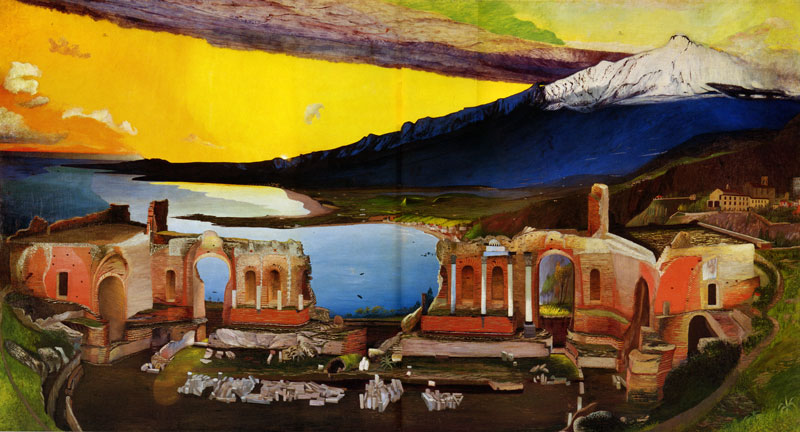
Csontvary, Ruins of the Greek Theater in Taormina, 1904 - '05
![]()
His strong colours as well as the poses and faces of his figures, look expressionism, although he was totally on his own, never lived in Paris nor in Germany and never took lessons with some other artist.
In his "Ruins of Taormina" (1904 - 5), five meter seventy long and painted precisely, the colours look as from expressionism: the air is partly strong yellow, the mountains ultramarine, the sea is divided in coloured areas, the buildings are pink. His "Baalbek" (7,16 m long, from 1906) is in green-blue and vivid red areas and squares. Shapes are deformed for the expressivity, as in "Horsemen at the Coast" (1909) or the sailing boats in "Castellamare di Stabia" (1902). His "Roman Bridge in Mostar" is half cubism and very expressive, the use of squares reminds Cezanne, although with Contvary they are clearly marked out. The colours are intense and have a dramatic effect. Contvary was a pharmacist until he got a vision wherein he was told he was preoccupied to become the greatest painter of all ages. His vision is regarded in literature as a burst of madness, but one must agree he can be regarded as one of the greatest.
Copyright for the text of all pages of this History of Modern Painting: Johan Framhout; text written in 1990-92; revisionned and put on the internet in 2005; translation in English 2012

